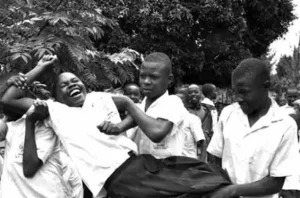 There are many diseases that can become an epidemic, but I never expected laughter to be one of the. After all, isn’t laughter a good thing? It is known as the “best medicine” as far as I have ever heard. Nevertheless, I suppose that one can have too much of a good thing. Such was the case on January 30, 1962, in or near the village of Kashasha on the western coast of Lake Victoria in Tanganyika (which, once united with Zanzibar, became the modern nation of Tanzania) near the border with Uganda. On that day the Tanganyika laughter epidemic of 1962 began. It was then that the outbreak that was categorized as an outbreak of mass hysteria, or mass psychogenic illness (MPI), was rumored to have occurred.
There are many diseases that can become an epidemic, but I never expected laughter to be one of the. After all, isn’t laughter a good thing? It is known as the “best medicine” as far as I have ever heard. Nevertheless, I suppose that one can have too much of a good thing. Such was the case on January 30, 1962, in or near the village of Kashasha on the western coast of Lake Victoria in Tanganyika (which, once united with Zanzibar, became the modern nation of Tanzania) near the border with Uganda. On that day the Tanganyika laughter epidemic of 1962 began. It was then that the outbreak that was categorized as an outbreak of mass hysteria, or mass psychogenic illness (MPI), was rumored to have occurred.
The laughter epidemic began at a mission-run boarding school for girls in Kashasha. It started with three girls and quickly spread throughout the school, affecting 95 of the 159 pupils between the ages of 12 and 18. I wonder if the teacher thought the girls were just trying to cause trouble or disrupt classes? The symptoms lasted from a few hours to as much as 16 days, with the average being around 7 days. Strangely, the teaching staff was not affected, other than to report that students were unable to concentrate on their lessons. All told, the first outbreak in Kashasha lasted about 48 days. It was just too long to be able to successfully run the school, so the school was forced to close on March 18, 1962. Unbelievably, a second phase of the outbreak began when the school reopened on May 21, 1962. This second phase of the outbreak affected an additional 57 pupils. The all-girl boarding school reclosed at the end of June.
You might think that the girls were just having a great time messing with their teachers, but the epidemic spread to Nshamba of the Muleba District, a village 55 miles west of Bukoba, where several of the girls lived. In  April and May 1962, 217 villagers, mostly young people had laughing attacks over the course of 34 days. In a crazy twist, the Kashasha school was sued for “allowing” the children and their parents to transmit it to the surrounding area. In June, the laughing epidemic spread to Ramashenye girls’ middle school, affecting 48 girls. Additional schools and the Kanyangereka village were also affected to some degree. About 18 months after it started, the Laughing epidemic simply died off. It was contained to the areas within a 100-mile radius of Bukoba. In all, 14 schools were shut down and 1000 people were affected.
April and May 1962, 217 villagers, mostly young people had laughing attacks over the course of 34 days. In a crazy twist, the Kashasha school was sued for “allowing” the children and their parents to transmit it to the surrounding area. In June, the laughing epidemic spread to Ramashenye girls’ middle school, affecting 48 girls. Additional schools and the Kanyangereka village were also affected to some degree. About 18 months after it started, the Laughing epidemic simply died off. It was contained to the areas within a 100-mile radius of Bukoba. In all, 14 schools were shut down and 1000 people were affected.
Symptoms of the Tanganyika “laughter epidemic” included laughter and crying, beside general restlessness and pain, as well as fainting, respiratory problems, and rashes. Contrary to the name, this was a very really epidemic with very real health concerns. Many of the symptoms experienced were stress-induced due to various external factors. This kind of stress and anxiety provokes mass hysteria outbreaks, which are reactions to perceived threats, cultural transitions, instances of uncertainty, and social stressors. You would think that these kinds of stressors would be common and happen to people every day. Maybe they were, but for whatever reason, this time, these stressors seemed much worse to those suffering with them. On top of that, the majority of the population affected by this epidemic were young people and adolescent children. The outbreak has been attributed to the young not having the appropriate coping skills to manage such stresses and anxieties. In addition to those stressors, the young people have a need for acceptance and are eager to blend into a group, making them vulnerable to “influence” contagion. Influence contagion refers to “the subtle and sometimes unwitting spread of emotions or behaviors from one individual to others. It occurs when people  influence each other’s thoughts, feelings, or actions without necessarily being aware of it.”
influence each other’s thoughts, feelings, or actions without necessarily being aware of it.”
Basically, in this cast, linguist Christian F Hempelmann theorized that the episode was stress-induced. “In 1962, Tanganyika had just won its independence, he said, and students had reported feeling stressed because of higher expectations by teachers and parents.” MPI, he says, usually occurs in people without a lot of power. “MPI is a last resort for people of a low status. It’s an easy way for them to express that something is wrong.” Whatever the case may be, the “laughter epidemic” ended up being a very real phenomenon.


Leave a Reply